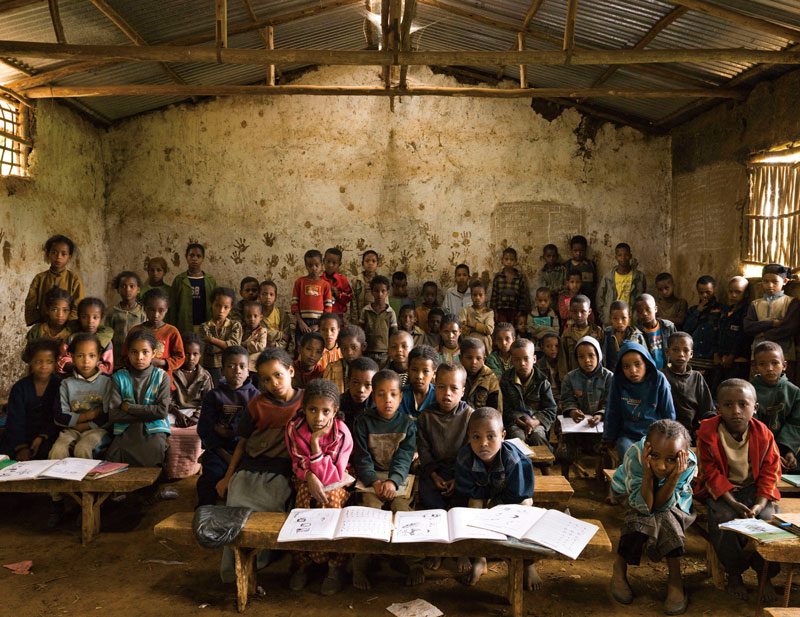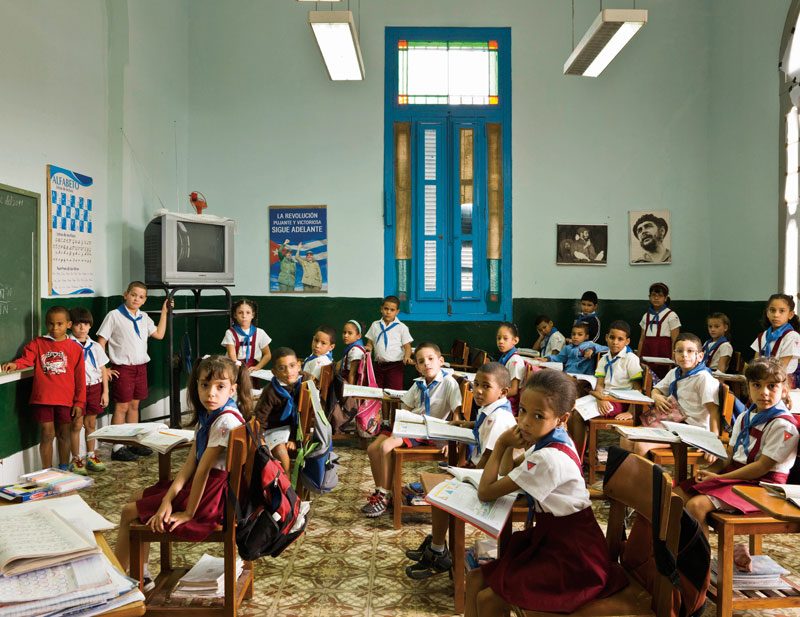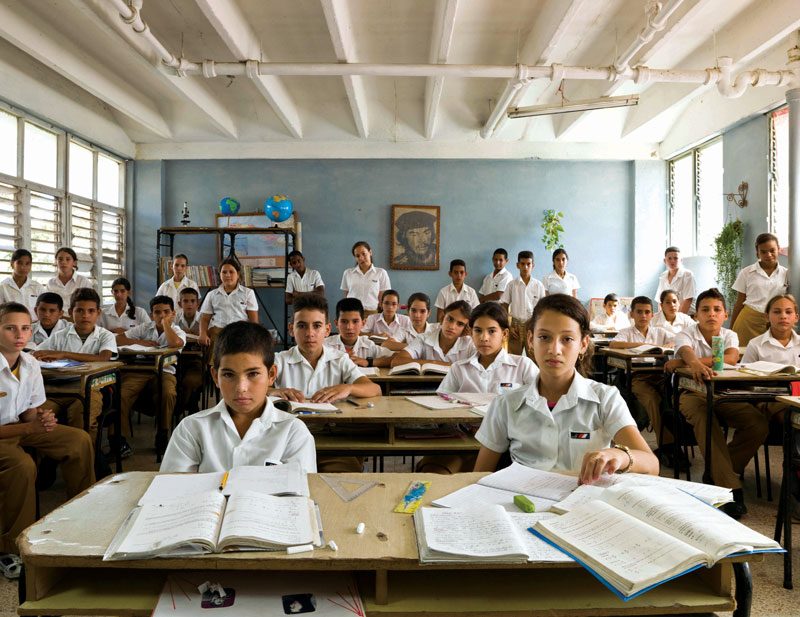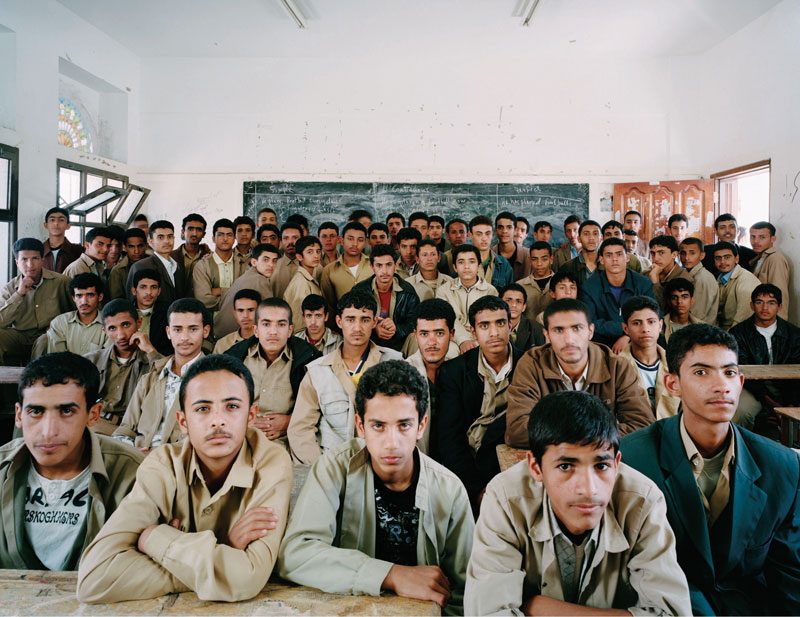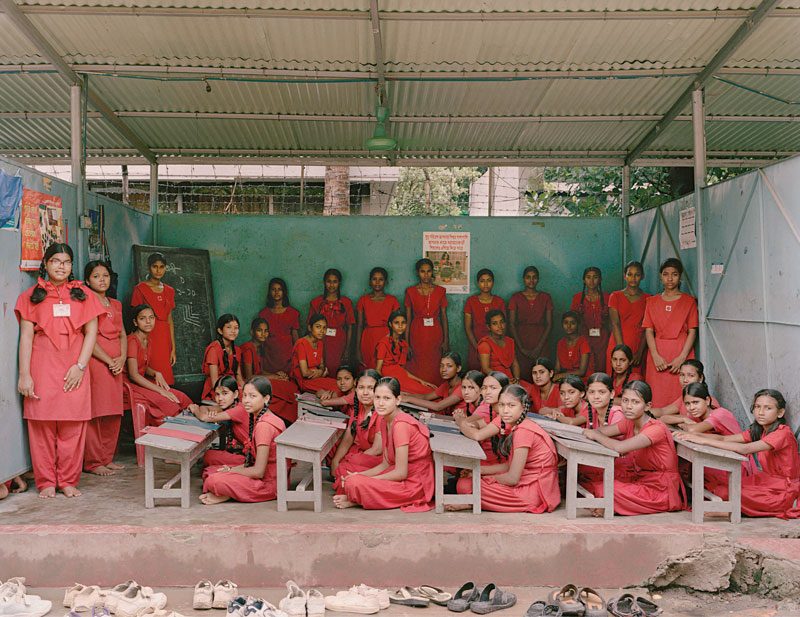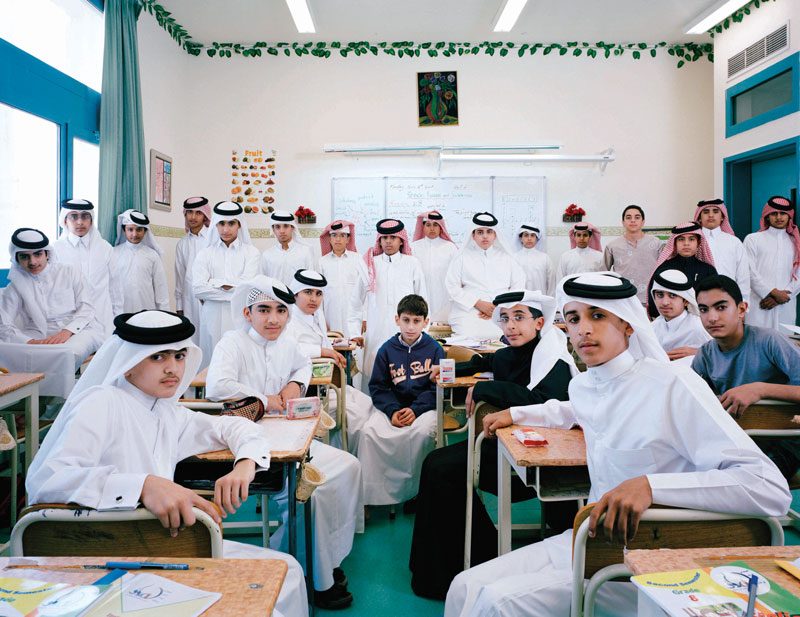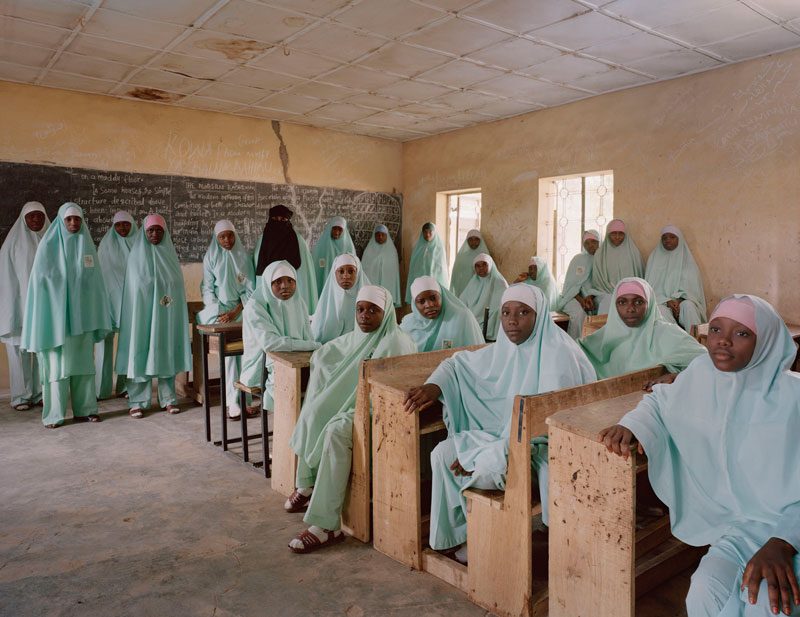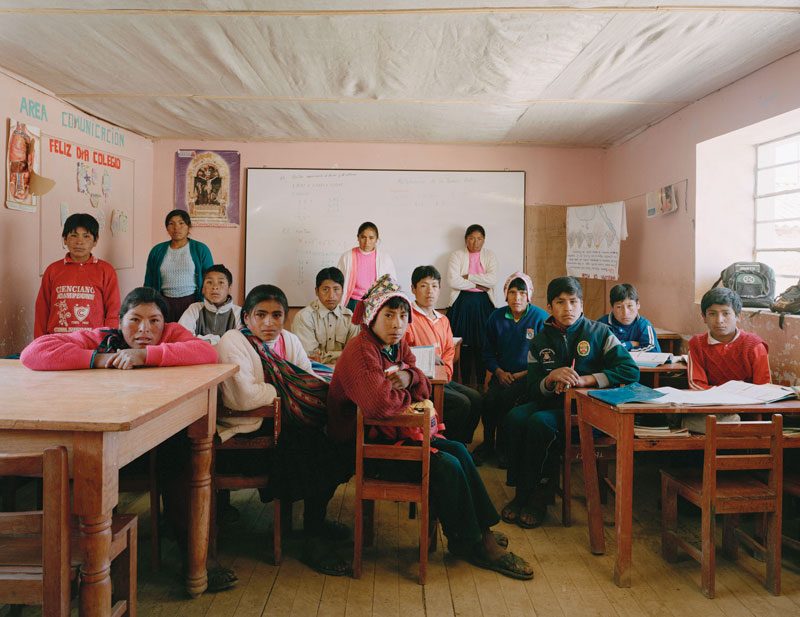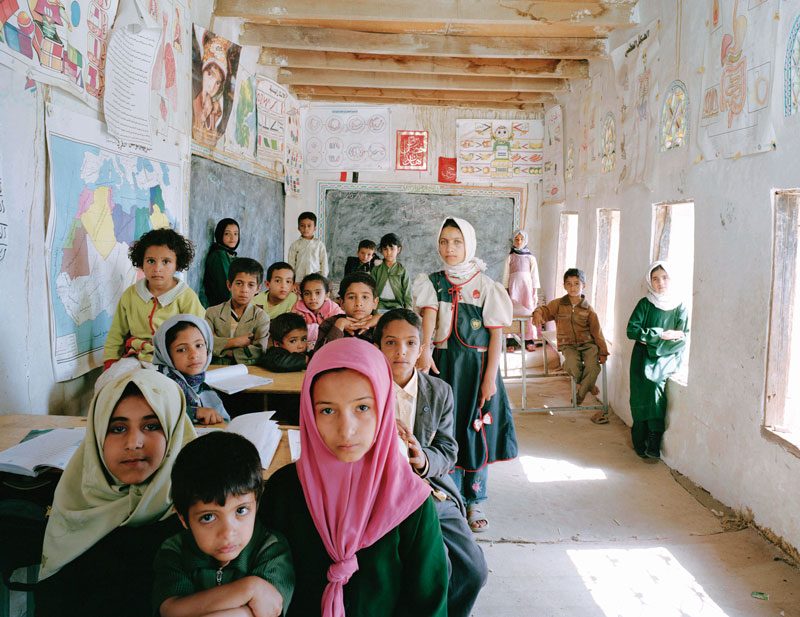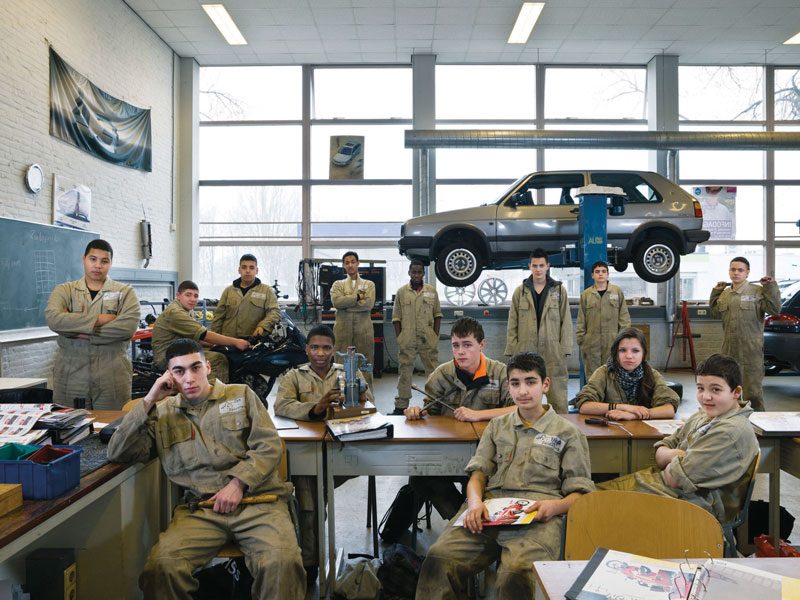You began working on the Classroom Portraits series about twelve years ago. Did you envision this project as a long-term series from the very beginning?
It started off in the northeast U.K., where I am based. I had received funding at the time to photograph in six particular schools. I realized pretty soon that it would be interesting to expand to other schools in different parts of the country, in that it was a way to make a portrait of the population. For example, one of the earliest schools I worked with is in a town called Washington in the northeast U.K., about seventy miles from Bradford. Bradford is a big immigrant city, whereas the population in Washington is essentially white. I could see rather quickly that schools tend to be very geographical, which makes for quite an interesting way to look around at different parts of the country.
What made you decide to branch out to look at schoolchildren in other countries?
To be honest, I was invited to do a workshop in Argentina, and I had already had a longstanding project that I was working on in Brazil. I had a trip scheduled in 2005, and while I was in both places, I thought that I would at least try to make portraits there. I must admit, I didn’t think that it would have the same resonance – and they do work differently – but for people from Britain who had seen the earlier work, a lot of the connections that you make have to do with your own childhood. When looking at an entirely different culture, I didn’t necessarily expect that to come through. Although it may not make the same connection, on the other hand, other things happen and you start to read other things into the pictures. There are similarities and differences wherever you are, but I liked opening it up and approaching things in a slightly different way. After that, I just took opportunities as they arose. Things grew in a fairly random way, and then the British Council got involved and commissioned me to visit certain countries, and the series continued to grow over the years. It wasn’t the only project that I was working on, but it was always nice to work on, so I carried on.
I find the portraits a bit unsettling, and I think this has to do with the fact that although they are all dissimilar, if you spend time looking at a large group of pictures, inevitably your eye begins to dance between what is similar and what is different. The common factor in all of them is the absence of adults and, of course, the fact that they are not formal school portraits in the manner that one might have of oneself or of one’s own children. In looking at just a group of children, it feels as if you have been offered a rare glimpse into their world, on their level.
The camera is on their level, and the images are based on the practice of photographing the class as a group. In traditional school portraits, you never get a real sense of what the school looks like. I stuck with the philosophy of photographing every child and making sure that they were all in the group. I never told the children not to smile, but equally I didn’t tell them to do so, either. If asked, I would tell them that they needed to be ready. The choreography of the process is what creates that look of expectation.
Is it a participatory experience – do they get to choose where they sit, and are they in on the choreography?
Not specifically, because of the restrictions of the space – you need to look through the camera to make sure that everyone is in the shot. It is collaborative in the sense that they have to go along with it. It requires all of them to settle in and concentrate while the portrait is being made. There’s quite a lot to do in that time: while their lesson is going on, I am setting up the camera and putting up lights – they need to get used to me even when they are having their maths or French lesson, or whatever it is they are doing. They are aware of all of the paraphernalia that is being erected all around them and they sense that I am taking this very seriously and precisely, so when it comes time for me to talk with them about what we will need to do to make it work, they understand and they go along with it. They get that it is complicated for them and for me, requiring their concentration as well as mine. We have to work together to pull it off. I like that a sort of atmosphere is created in the process of making the picture.
Do the children get to see what you have made? Have they ever told you what they think of the portraits?
Yes, they do get to see them. Where possible, it is an Internet thing, and I email pictures to the schools. When that isn’t possible, I send actual photographs – and where the kids are really poor, I send every child a print. For a group in Ethiopia, for example, I sent thirty copies of the portrait so they could hand it out to all the kids.
Have you ever gone back to re-photograph a class?
I have done this with my daughters’ classes. In the end, that constitutes something else, which could happen. I’ve thought about doing lots of different things as this has unfolded. But groups don’t stick together, and so I wouldn’t have the same kids. And with the secondary-school classes, they all split up and do different subjects. For logistical reasons, it all becomes a bit complicated. I’ve also thought about doing work related to playgrounds, because again this is a completely different experience, where kids can do as they please. The ones who want to be alone do so and those who form little groups do so by their own design. It’s quite fascinating to observe. These I imagine as landscapes in which we might see kids as they are.
To me, the images straddle this very interesting space between portraiture and documentary, because although you get a sense of the children, it is as a collective. Invariably, in looking from one image to another, you make comparisons about the surroundings that the children are in – what they are wearing and always how they appear in the group. There are startling contrasts among levels of privilege that are evident within the frame.
There are obviously vast differences between the facilities available to a child in northern Nigeria and those available to a child in Germany. That is part of the series, but at the same time, the template of an oblong space – whether blackboard or smart board, is pretty much universal. I was a bit anxious about how the portraits are laid out in the book, because you do have the power to choose the juxtapositions. In the end, I attempted to resolve the issue by putting the portraits chronologically into the book, which makes it come through as more of a journey. So there are contrasts, but they also come through time, rather than deliberate oppositions. But yes, you are right, I think that the series is a document – but it is a speck in the ocean. There are far more countries that I haven’t been to than those that I have, and I’ve been to only a few schools in each country. This is not a scientific survey, but nonetheless it is a record of what education looks like, and of what a country offers its kids. For me, the philosophical discussion going on behind the images is something about democracy, because I am trying to give attention to every child, whether he or she is in the front or in the back. In the process of making these portraits, I try to give them all space, to let them all be seen, and I work very hard to try to achieve that. And I find the pictures very challenging to look at, too.
Johanna Mizgala is the curator of the House of Commons Collection and a PhD candidate in cultural mediations at Carleton University. Her interest in commemoration and the persuasive power of photography stems from a longstanding investigation of memory and photography, of longing and loss, and of identity politics.
Julian Germain’s work is characterized by an interest in social issues and a belief in the value of amateur and “functional” images. He has published several photobooks – with SteidlMack, among others – some of which combine his own images with pictures from various sources. He sits on the editorial board of the magazine Useful Photography, with Erik Kessels. He has exhibited his work internationally, notably in London, Tokyo, Sao Paulo, and Rotterdam. Since 1995, he has been working with Brazilian artists Patricia Azevedo and Murilo Godoy on collaborative projects with favela communities and street children. He lives and works in Northumberland, U.K.
www.juliangermain.com

